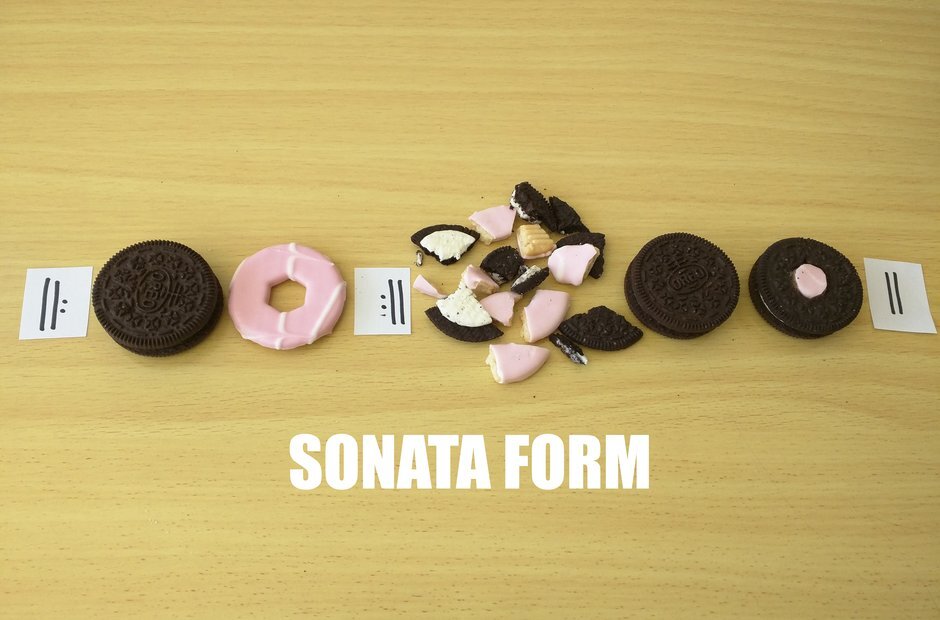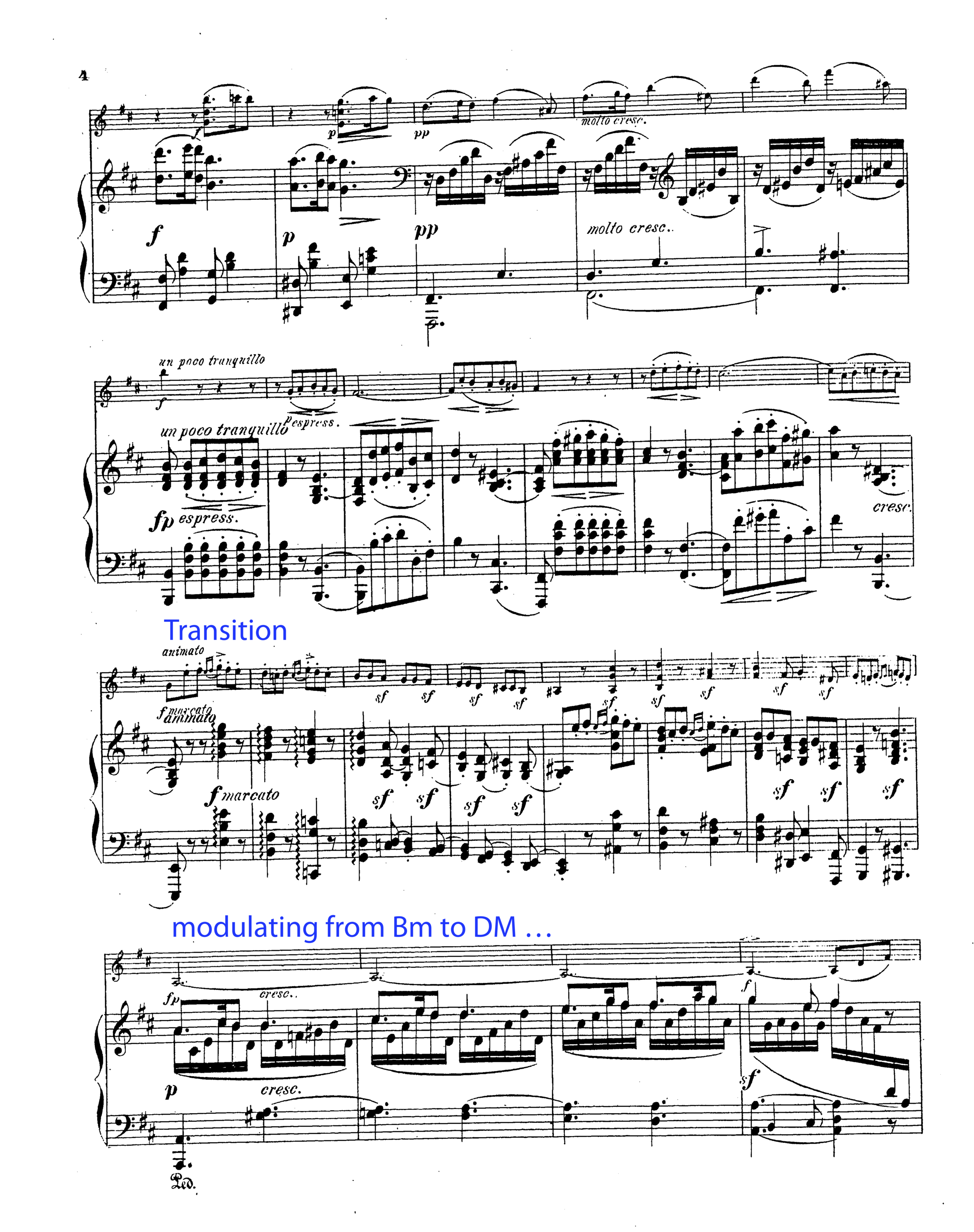SONATA-ALLEGRO FORM
This page is a supplement to The Complete Musician: Chapter 27 - Sonata Form
“SONATA” DEFINED
The term “Sonata” can refer to quite a few concepts in music and is, therefore, a bit confusing if you are unclear what someone is referring to. The very first definition of SONATA was a multi-movement work for solo instrument (or instrument with piano/keyboard accompaniment) that came about during the Baroque era of classical music. A Sonata is to a solo instrument what a Symphony is to a symphony orchestra - a large-scale work in contrasting but related styles, tonalities, and themes.
These are all sonatas:
Sonata quasi una fantasia, No.14 in C# Minor (1801) - Ludwig van Beethoven
Easter Sonata (1828) - Fanny Mendelssohn
Sonata for Solo Cello (1915) - Zoltán Kodály
Piano Sonata in E Minor (1932) - Florence Price
https://rampages.us/mhis243/lectures/lesson-8/sonata-allegro-form/
The first movement of a typical Sonata is written in a complex form similar to rounded binary or ternary form but much more involved. Composers started using this movement form in other non-sonata works such as symphonies, concerti, and other orchestral and chamber settings. It kept its origin as its namesake, being referred to as the SONATA FORM (which I find confusing), the SONATA-ALLEGRO FORM (since it originated from the allegro first movement of the sonata), or the FIRST MOVEMENT FORM (which isn’t always true because it can be found outside the first movement). Classical music theorists go nuts for this form, considering it to be the pinnacle of elegant genius in Western Classical Music as it balances complexity with simplicity and variety with familiarity in, what many believe, is a perfect ratio.
This “perfect ratio” is achieved by following a fairly structured format with room for the composer’s unique voice and expression. This form is outlined below:
INTRODUCTION: While not necessary, many sonata-allegro form movements begin with a very slow introduction, especially if it is the first of a very large-scale work such as a symphony. The introduction may be in tonic, a non-tonic key center, or multiple key centers.
EXPOSITION: This could be considered the large A section of the movement in which all the material is stated for the first time. In general, the Exposition is divided between two themes (an A theme and a B theme) in two contrasting but related keys. Most expositions have a note-for-note repeat through the use of a repeat sign around the section ||: exposition :||
THEME I/A/FTA: This is the first full theme of the movement stated in the tonic key - The Complete Musician refers to this area as the First Tonal Area to put more emphasis on the key than the melody. This is because sometimes, a Sonata-Allegro movement can be MONOTHEMATIC where both themes of the exposition are essentially the same theme, just presented in two different key centers.
TRANSITION: Because the following theme is in another, non-tonic key, there is generally a short transition to modulate or set up to the new key between the two themes of the exposition.
DEPENDENT TRANSITION (DTr): this is when the transition uses material from the first theme
INDEPENDENT TRANSITION (ITr): this is when the transition uses all new material
THEME II/B/STA: This is the second full theme stated in the exposition. If the tonic key is major, the second theme is most likely in the dominant major key (V); if the tonic is minor, the second theme is likely presented in the mediant major key (III). The text calls this part the Second Tonal Area to refer to the key changing rather than the statement of a new melody.
CLOSING SECTION: This is the final part of the second area of the exposition. It is still in the second tonic area and still using melodic content of the second theme, but it generally is a very strong, resolute “coda” of the theme to show that the exposition section is drawing to a close, preparing the listener to move to new material.
DEVELOPMENT: This is the “fun” part where small motifs and snippets of Theme I and Theme II are processed, overlapped, transformed, mutated, flipped on their heads, and tossed around into new but somewhat familiar settings. There is no specific tonality this section must be in and it is frequently ambiguous or sequences through multiple tonalities that might be distantly related from the tonic. As the Development draws to a close, a RETRANSITION (RTr) will signal the move back to tonic and a revisiting of the Exposition which will be called the Recapitulation because it is not an identical repeated section. Be careful at hints of the next section (Recapitulation) occurring in non-tonic keys which hint or trick the listener into thinking the final section has been introduced - this is called FALSE RECAPITULATION.
RECAPITULATION: This is the “recap” of the Exposition but with a few key differences: the first is that all the material presented in the Exposition is now in the tonic key including any transitional material, Theme II/B/STA and the Closing Section. On occasion, the Expositional Material (especially Theme I) might be slightly abbreviated - as if just calling back to the idea rather than repeating it note-for-note. Finally, most Sonatas (although there are exceptions) end with a Coda.
CODA: A Coda is a musical device that ends many large-scale works, not just Sonata-Allegro form. The direct translation of Coda from Italian is “tail” which implies its importance as a functional appendage of a piece, but is actually unnecessary (a cat is still a cat without a tail). Codas often include a very abbreviated or blended statements of previous themes. Imagine the Coda as the Epilogue of a story - it’s not necessary, but it can be sure nice to revisit and know!
Here is another helpful visual for understanding Sonata form which especially highlights its differences from ternary or binary form:
Note that the two whole cookies in the Exposition section will always differ in color and appearance (tonality) and usually in flavor (unique first and second theme) but sometime they still taste the same (monothematic) kind of like how all M&M’s taste the same even though they are different colors.
The little Oreo at the end with the bit of pink icing cookie represents Theme II and Closing Themes which now reappear in the tonic key for the Recapitulation.
Notice how the Exposition repeats while the Development and Recapitulation are performed one time through.
SONATA-ALLEGRO FORM EXAMPLE
One complication of studying sonata-allegro form is that, since it is one of the largest extended forms you can study, it takes up a lot of space! Here is an 11-page example of the first movement, I. Allegretto, in sonata-allegro from from AMANDA MAIER’s 1878 Sonata for Piano and Violin. Follow along with the recording (0:00-9:15) and decide where you believe the Exposition, Development, and Recapitulation are, including tonality, Theme I and Theme II, transitions and retransitions if any, introduction and coda if any - and why.
As always, it’s a good idea to make an educated guess about assigning a formal area to a particular measure because of perhaps one familiar element you’re noticing - but then you must find additional evidence to prove your point. Evidence can come in the form of melodic material, harmonic material, phrases and pacing of pattern or measures, texture, range, tempo or style markings, key signature change or unmarked modulations, rhythmic material, or any other elemental markers that denote something new or the return of something expected.
When you are done with your decision-making, scroll lower to see an analyzed copy of the movement to see how many sections you got right.
AMANDA RÖNTGEN-MAIER (1853-1894) was a Swedish composer and violinist who wrote for solo and chamber instruments and performed throughout Europe. She was the first woman to graduate with a music degree in Sweden.
When you you think you have a good idea where each of the formal areas are (based on listening, looking for changes and patterns, context clues and evidence, scroll down to reveal both the score and graphical analysis and check your work).
SONATA-ALLEGRO FORM ANALYSIS
This is a GRAPHICAL FORM ANALYSIS of the Sonata we are studying - this is an important tool for analyzing large-scale works that have long page counts and time durations. However long the piece is, you can break it down into a single linear graph (in this one, I have 10-measure plot points) and easily show the pacing and order of events over the whole (9-minute) piece.





























